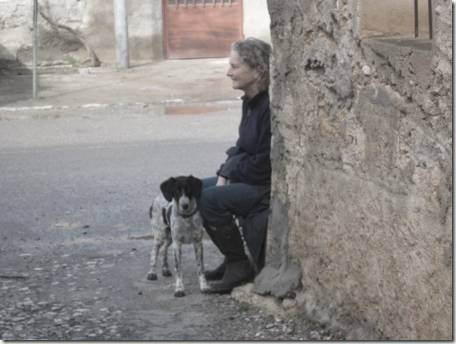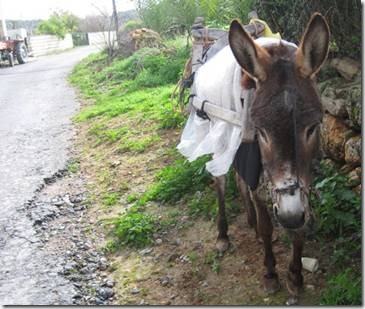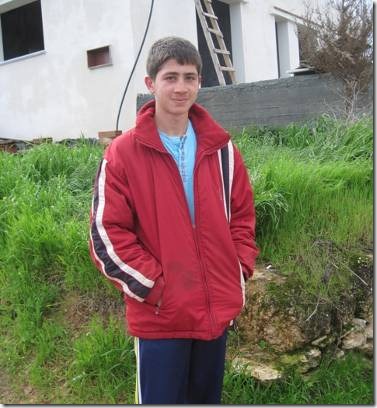Last Sunday we went to visit the small village of Büyükkonuk. I hope to write about that soon. This email is about yesterday.
Ru
Çarşamba Sabah Şubat 8, 2012
(Wednesday Morning February 8, 2012)
Yesterday Sharman, Sophie and I set off from the marina at 8 am. By the time we returned at 1 pm we’d had a lovely long walk along the coast to the old carob warehouses, a very quick visit to the Yenierenköy Halk Kütüphanesi ( Public Library), tea and Toast (cheese Panini) in Yenierenköy, and then a walk back through Sipahi where I was finally able to take a photo of a young friend Selahattin Cakmok.
The weather was mostly warm, with short periods of light rain alternating with sun. Just as we would dry, the rain would come again. Sharman and I had rain gear and enough clothes to keep us warm in the rain and a bit too warm in the sun; but Sophie doesn’t like the rain one bit and would look at us with a very sad expression when we expected her to come along and not hide in the bushes or under a tree.
I’ve shown photos of the carob warehouse in other email so I left the camera in my backpack most of the morning. And the woman in charge of the library doesn’t speak English so I need to have a longer visit before I take the photos there. But I did finally get a photo of a young friend who we happened to meet along the way.
Sharman and Sophie in Sipahi on our way home.
Tractor and donkey…
I had to go pat the donkey and scratch its ears but actually hadn’t even noticed the tractor until downloading the photos. Both donkeys and tractors are part of the charm of the Karpaz Peninsular.
Selahattin Cakmok
I had written about Selahattin in earlier emails but had failed to take a photo or learn his name. Now I know. He attends the high school in Yenierenköy.
Here is the story about how the photos came to be taken during our walk.
The road from Yenierenköy rarely has traffic, even Monday mornings when most villagers go to the local market. Wednesday was a different story. It seemed as if we were being passed by cars every two minutes! Then a parade of UN Peacekeeping vehicles went by. The Greek Cypriots living in North Cyprus are officially classified as refugees so they are given supplies by the UN. (The Turkish Cypriots who live below the green line in the south get no UN assistance.) In the center of Sipahi are a Greek Church and, next door, a building where Randal and I have seen UN soldiers in the past. When Sharman, Sophie and I arrived there Wednesday, a number of people were gathered as well as boxes and bags of food and other supplies. First I thought there was some kind of “local market” but then guessed it was the time when people came to collect their UN supplies which would explain the increased traffic. Everyone was friendly and said hello and we said hello. I didn’t attempt Turkish since I wasn’t sure what language they spoke and didn’t want to make any political statement which apparently you can do when you speak either Turkish or Greek. While researching UN deliveries to the Greeks in Northern Cyprus for this email I found some information from GuardianGate http://leaks.hohesc.us/?origin=Embassy%20Addis%20Ababa which pulled the information from Wikileaks a site I haven’t ever searched. I don’t think I actually approve of them but the document I read was unclassified, so I am including parts of it that relate to Sipahi which is also called Agias Trias. The "enclaved" refers to the Greek Cypriots living in Northern Cyprus. There are 3 enclaves, the one in Sipahi is the second largest. From what I read, the larger the community, the better it all seems to work for all concerned.
4. (U) Under the terms of the 1975 Vienna III Agreement, (ending the fighting between Greek and Turkish Cypriots and military sent from Turkey to protect Turkish Cypriots,)
civil affairs officers from the United Nations Peacekeeping
Force in Cyprus (UNFICYP) monitor the condition of the
enclaved in the north, facilitate medical care, deliver
supplies money provided through the Red Cross by the GOC
(pension payments and the like, usually in cash), and
informally seek to resolve disputes involving the enclaved,
their Turkish Cypriot neighbors, and "TRNC" officials.
Accordingly, UNFICYP conducts regular weekly patrols to the
Karpass region, visiting the designated Greek Cypriot
spokespersons in each of the three villages and making
informal home visits. UN convoys also visit the enclaved
Maronites in the northwest every fortnight. http://leaks.hohesc.us/?view=06NICOSIA2051
………………………………………
13. (SBU) Although Liasi was visibly happier and more
prosperous than Kananka (he joked with the Turkish Cypriot
cop who accompanied the patrol and stressed to us that the
villagers got on quite well with their neighbors, learning
each other’s languages and interacting freely) the Greek
Cypriots of Agias Trias face the same demographic pressures
that threaten the Leonarissa enclaved. While more numerous,
Agias Trias’s villagers are still comparatively old, since
nearly all of the town’s children moved south long ago in
search of education, jobs, and marriage prospects. The
village’s only wedding in recent memory had taken place a few
months earlier, between a local woman in her sixties and a
former resident (now living in the south) who was at least as
old. Even if Turkish Cypriot authorities respond positively
to the new husband’s request for permission to reside in the
village permanently (he can now visit on a "tourist visa" for
90 days at a time), it still seems likely that Greek Cypriot
life in Agias Trias will slowly fade away as the residents
die off. http://leaks.hohesc.us/?view=06NICOSIA2051
This document was written in 2006 and if things have changed, I don’t know. Being comparatively short-term visitors, and unable to speak Turkish, we mostly avoid becoming involved in local issues. We just try to be good Americans and treat everyone well and hope for the best for Cyprus. What I do know is how friendly everyone in Sipahi and Yenierenkoy has been to us.



